Ford F-350 2005, F-550 2005, F-450 2005, F-250 2005 Owner Manual
|
Table of Contents |
|
|
Introduction |
4 |
|
|
|
|
Instrument Cluster |
12 |
|
|
Warning and control lights |
12 |
Gauges |
15 |
|
|
Entertainment Systems |
20 |
|
|
AM/FM stereo |
20 |
AM/FM stereo with CD |
22 |
AM/FM stereo cassette with CD |
25 |
AM/FM stereo with in-dash six CD |
28 |
|
|
Climate Controls |
33 |
|
|
Heater only |
33 |
Manual heating and air conditioning |
34 |
Automatic temperature control |
36 |
|
|
Lights |
39 |
|
|
Headlamps |
39 |
Turn signal control |
44 |
Bulb replacement |
45 |
|
|
Driver Controls |
54 |
|
|
Windshield wiper/washer control |
54 |
Steering wheel adjustment |
54 |
Power windows |
57 |
Mirrors |
58 |
Speed control |
61 |
Upfitter controls |
64 |
Moon roof |
66 |
Message center |
68 |
|
|
Locks and Security |
80 |
|
|
Keys |
80 |
Locks |
80 |
1

Table of Contents
Seating and Safety Restraints |
90 |
|
|
Seating |
90 |
Safety restraints |
97 |
Airbags |
108 |
Child restraints |
117 |
|
|
Tires, Wheels and Loading |
129 |
|
|
Tire Information |
132 |
Tire Inflation |
133 |
Vehicle loading |
148 |
Trailer towing |
155 |
Trailer Brake Controller-Integrated |
159 |
Recreational towing |
165 |
|
|
Driving |
167 |
|
|
Starting |
167 |
Brakes |
172 |
Transmission operation |
176 |
|
|
Roadside Emergencies |
202 |
|
|
Getting roadside assistance |
202 |
Hazard flasher switch |
204 |
Fuel pump shut-off switch |
204 |
Fuses and relays |
205 |
Changing tires |
214 |
Lug Nut Torque |
225 |
Jump starting |
226 |
Wrecker towing |
232 |
|
|
Customer Assistance |
234 |
|
|
Reporting safety defects (U.S. only) |
240 |
|
|
Cleaning |
241 |
|
|
2
|
Table of Contents |
|
|
Maintenance and Specifications |
249 |
|
|
Engine compartment |
251 |
Engine oil |
254 |
Battery |
258 |
Engine Coolant |
260 |
Fuel information |
266 |
Air filter(s) |
284 |
Part numbers |
286 |
Refill capacities |
287 |
Lubricant specifications |
290 |
|
|
Accessories |
302 |
|
|
|
|
Index |
305 |
|
|
All rights reserved. Reproduction by any means, electronic or mechanical including photocopying, recording or by any information storage and retrieval system or translation in whole or part is not permitted without written authorization from Ford Motor Company. Ford may change the contents without notice and without incurring obligation.
Copyright © 2005 Ford Motor Company
3
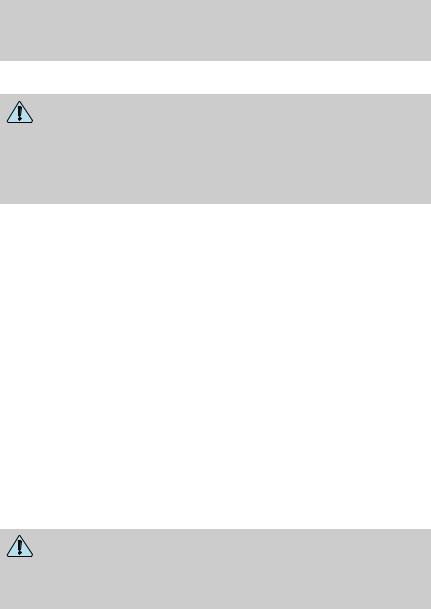
Introduction
CALIFORNIA Proposition 65 Warning
WARNING: Engine exhaust, some of its constituents, and certain vehicle components contain or emit chemicals known to
the State of California to cause cancer and birth defects or other reproductive harm. In addition, certain fluids contained in vehicles and certain products of component wear contain or emit chemicals known to the State of California to cause cancer and birth defects or other reproductive harm.
CONGRATULATIONS
Congratulations on acquiring your new Ford. Please take the time to get well acquainted with your vehicle by reading this handbook. The more you know and understand about your vehicle, the greater the safety and pleasure you will derive from driving it.
For more information on Ford Motor Company and its products visit the following website:
•In the United States: www.ford.com
•In Canada: www.ford.ca
•In Australia: www.ford.com.au
•In Mexico: www.ford.com.mx
Additional owner information is given in separate publications.
This Owner’s Guide describes every option and model variant available and therefore some of the items covered may not apply to your particular vehicle. Furthermore, due to printing cycles it may describe options before they are generally available.
Remember to pass on this Owner’s Guide when reselling the vehicle. It is an integral part of the vehicle.
Fuel pump shut-off switch: In the event of an accident the safety switch will automatically cut off the fuel supply to the
engine. The switch can also be activated through sudden vibration (e.g. collision when parking). To reset the switch, refer to the Fuel pump shut-off switch in the Roadside Emergencies chapter.
4
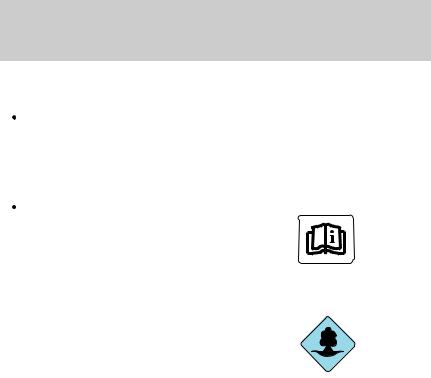
Introduction
SAFETY AND ENVIRONMENT PROTECTION
 Warning symbols in this guide
Warning symbols in this guide
How can you reduce the risk of personal injury to yourself or others? In this guide, answers to such questions are contained in comments highlighted by the warning triangle symbol. These comments should be read and observed.
 Warning symbols on your vehicle
Warning symbols on your vehicle
When you see this symbol, it is imperative that you consult the relevant section of this guide before touching or attempting adjustment of any kind.
Protecting the environment
We must all play our part in protecting the environment. Correct vehicle usage and the authorized disposal of waste, cleaning and lubrication materials are significant
steps towards this aim. Information in this respect is highlighted in this guide with the tree symbol.
BREAKING-IN YOUR VEHICLE
During the first 1,000 miles (1,600 km) of driving, maintain speeds below 70 mph (112 km/h) and vary speeds frequently. This is recommended to give the moving parts a chance to break-in.
Do not tow a trailer or use your vehicle to snowplow until it has been driven at least 500 miles (800 km). Refer to Trailer towing in the Tires, Wheels and Loading chapter for more information on towing a trailer and Snowplowing in the Driving chapter.
Do not add friction modifier compounds or special break-in oils during the first few thousand miles (kilometers) of operation, since these additives may prevent piston ring seating. See Engine oil in the Maintenance and Specifications chapter for more information on oil usage.
5

Introduction
SPECIAL NOTICES
New Vehicle Limited Warranty
For a detailed description of what is covered and what is not covered by your vehicle’s New Vehicle Limited Warranty, refer to the Warranty Guide that is provided to you along with your Owner’s Guide.
Service Data Recording
Service data recorders in your vehicle are capable of collecting and storing diagnostic information about your vehicle. This potentially includes information about the performance or status of various systems and modules in the vehicle, such as engine, throttle, steering or brake systems. In order to properly diagnose and service your vehicle, Ford Motor Company, Ford of Canada, Ford Motor Company, S.A. de C.V. and service and repair facilities may access vehicle diagnostic information through a direct connection to your vehicle when diagnosing or servicing your vehicle.
Event Data Recording
Other modules in your vehicle — event data recorders — are capable of collecting and storing data during a crash or near crash event. The recorded information may assist in the investigation of such an event. The modules may record information about both the vehicle and the occupants, potentially including information such as:
•how various systems in your vehicle were operating;
•whether or not the driver and passenger seatbelts were buckled;
•how far (if at all) the driver was depressing the accelerator and/or the brake pedal;
•how fast the vehicle was traveling; and
•where the driver was positioning the steering wheel.
To access this information, special equipment must be directly connected to the recording modules. Ford Motor Company, Ford of Canada and Ford Motor Company, S.A. de C.V. do not access event data recorder information without obtaining consent, unless pursuant to court order or where required by law enforcement, other government authorities or other third parties acting with lawful authority. Other parties may seek to access the information independently of Ford Motor Company, Ford of Canada and Ford Motor Company, S.A. de C.V.
6
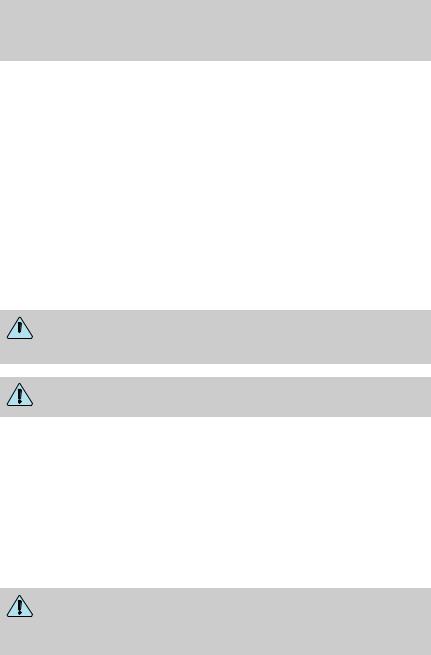
Introduction
Vehicle Modification Data Recording
Some aftermarket products may cause severe engine and/or transmission damage; refer to the What is not covered section in The new vehicle limited warranty for your vehicle chapter of your vehicle’s Warranty Guide for more information. Some vehicles are equipped with Powertrain Control Systems that can detect and store information about vehicle modifications that increase horsepower and torque output; this information cannot be erased and will stay in the system’s memory even if the modification is removed. When a dealer or repair facility works on your vehicle, it may be necessary for them to access the information in the Powertrain Control System. This information will likely identify if any unauthorized modifications have been made to the system and may be used to determine if repairs will be covered by warranty.
Special instructions
For your added safety, your vehicle is fitted with sophisticated electronic controls.
Please read the section Supplemental restraint system (SRS)  in the Seating and Safety Restraints chapter. Failure to follow the specific warnings and instructions could result in personal injury.
in the Seating and Safety Restraints chapter. Failure to follow the specific warnings and instructions could result in personal injury.
Front seat mounted rear-facing child or infant seats should NEVER be placed in front of an active passenger airbag.
Cell phone use
The use of Mobile Communications Equipment has become increasingly important in the conduct of business and personal affairs. However, drivers must not compromise their own or others’ safety when using such equipment. Mobile Communications can enhance personal safety and security when appropriately used, particularly in emergency situations. Safety must be paramount when using mobile communications equipment to avoid negating these benefits.
Mobile Communication Equipment includes, but is not limited to cellular phones, pagers, portable email devices, in-vehicle communications systems, telematics devices and portable two-way radios.
A driver’s first responsibility is the safe operation of the vehicle. The most important thing you can do to prevent a crash is to
avoid distractions and pay attention to the road. Wait until it is safe to operate Mobile Communications Equipment.
7

Introduction
Notice to owners of diesel-powered vehicles
Read the 6.0 Liter Power Stroke Direct Injection Turbo Diesel Owner’s Guide Supplement for information regarding correct operation and maintenance of your Diesel-powered light truck.
Notice to owners of pickup trucks and utility type vehicles
Utility vehicles have a significantly higher rollover rate than other types of vehicles.
Before you drive your vehicle, please read this Owner’s Guide carefully. Your vehicle is not a passenger car. As with other vehicles of this type, failure to operate this vehicle correctly may result in loss of vehicle control, vehicle rollover, personal injury or death.
Be sure to read Driving off road in the Driving chapter.
Using your vehicle with a snowplow
For more information and guidelines for using your vehicle with a snowplow, refer to the Driving chapter.
Using your vehicle as an ambulance
If your light truck is equipped with the Ford Ambulance Preparation Package, it may be utilized as an ambulance. Ford urges ambulance manufacturers to follow the recommendations of the Ford Incomplete Vehicle Manual, Ford Truck Body Builder’s Layout Book and the Qualified Vehicle Modifiers (QVM) Guidelines as well as pertinent supplements. For additional information, please contact the Truck Body Builders Advisory Service at 1–877–840–4338.
Use of your Ford light truck as an ambulance, without the Ford Ambulance Preparation Package voids the Ford New Vehicle Limited Warranty and may void the Emissions Warranties. In addition, ambulance usage without the preparation package could cause high underbody temperatures, overpressurized fuel and a risk of spraying fuel which could lead to fires.
8
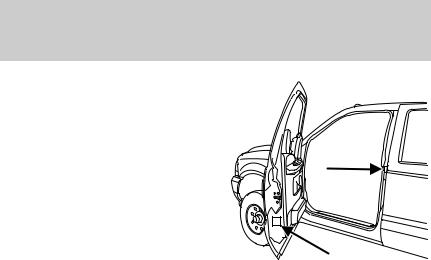
Introduction
If your vehicle is equipped with the Ford Ambulance Preparation Package, it will be indicated on the Safety Compliance Certification Label. The label is located on the driver’s side door pillar or on the rear edge of the driver’s door. You can determine whether the ambulance manufacturer followed Ford’s recommendations by directly contacting that manufacturer. Ford Ambulance Preparation Package is only available on certain 6.0L Diesel engine equipped vehicles.
Using your vehicle as a stationary power source (PTO)
Refer to the Driving chapter for more information and guidelines for operating a vehicle equipped with an aftermarket power take-off system.
Middle East/North Africa vehicle specific information
For your particular global region, your vehicle may be equipped with features and options that are different from the ones that are described in this Owner’s Guide; therefore, a supplement has been supplied that complements this book. By referring to the pages in the provided supplement, you can properly identify those features, recommendations and specifications that are unique to your vehicle. Refer to this
Owner’s Guide for all other required information and warnings.
9
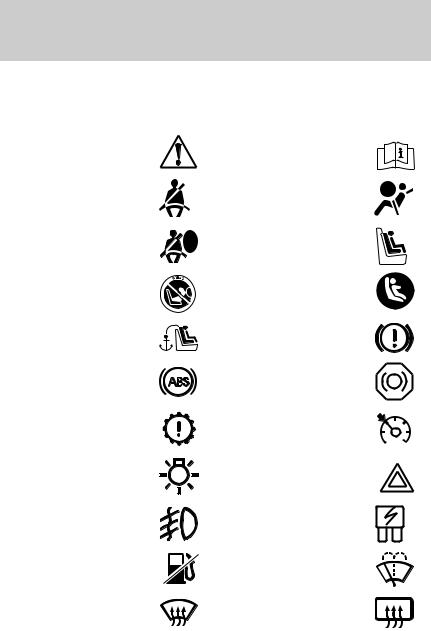
Introduction
These are some of the symbols you may see on your vehicle.
Vehicle Symbol Glossary |
||
Safety Alert |
See Owner’s Guide |
|
Fasten Safety Belt |
Airbag-Front |
|
Airbag-Side |
Child Seat |
|
Child Seat Installation |
Child Seat Lower |
|
Warning |
Anchor |
|
Child Seat Tether |
Brake System |
|
Anchor |
||
|
||
Anti-Lock Brake System |
Brake Fluid - |
|
Non-Petroleum Based |
||
|
||
Powertrain Malfunction |
Speed Control |
|
Master Lighting Switch |
Hazard Warning Flasher |
|
Fog Lamps-Front |
Fuse Compartment |
|
Fuel Pump Reset |
Windshield Wash/Wipe |
|
Windshield |
Rear Window |
|
Defrost/Demist |
Defrost/Demist |
|
10
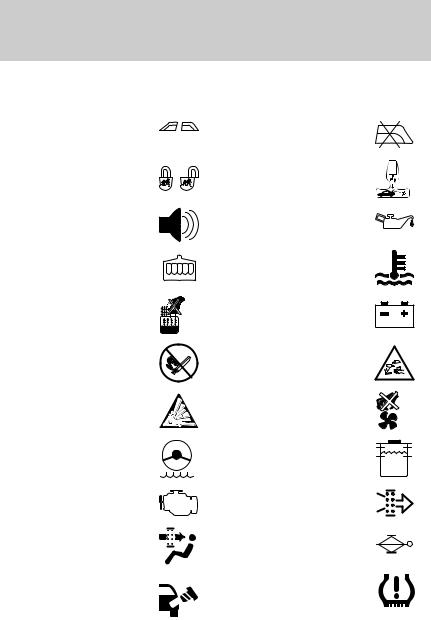
Introduction
Vehicle Symbol Glossary
Power Windows
Power Window Lockout
Front/Rear
Child Safety Door
Interior Luggage
Lock/Unlock
Compartment Release
Symbol
Panic Alarm |
Engine Oil |
Engine Coolant
Engine Coolant
Temperature
Do Not Open When Hot |
Battery |
Avoid Smoking, Flames,
Battery Acid
or Sparks
Explosive Gas |
Fan Warning |
Power Steering Fluid
Maintain Correct Fluid
Level
Emission System |
Engine Air Filter |
|
Passenger Compartment |
Jack |
|
Air Filter |
||
|
Check Fuel Cap
Low Tire Pressure
Warning
MAX
MIN
11

Instrument Cluster
WARNING LIGHTS AND CHIMES
Standard instrument cluster (manual transmission)
Standard instrument cluster (automatic transmission)
Amarillo instrument cluster
Warning lights and gauges can alert you to a vehicle condition that may become serious enough to cause expensive repairs. A warning light may illuminate when a problem exists with one of your vehicle’s functions.
12
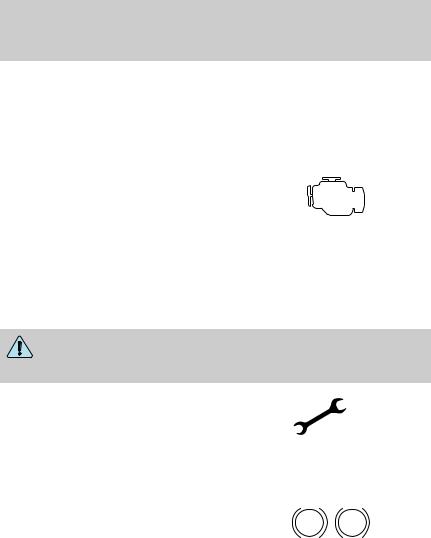
Instrument Cluster
Many lights will illuminate when you start your vehicle to make sure the bulbs work. If any light remains on after starting the vehicle, have the respective system inspected immediately.
If your vehicle is equipped with a diesel engine, it has a unique cluster, refer to Starting the engine in your 6.0 Liter Power Stroke Direct Injection Turbo Diesel Owner’s Guide Supplement.
Service engine soon: The Service engine soon indicator light illuminates when the ignition is first turned to the ON position to check
the bulb. Solid illumination after the engine is started indicates the On Board Diagnostics System (OBD-II) has detected a malfunction. Refer to
On board diagnostics (OBD-II) in the Maintenance and Specifications chapter. If the light is blinking, engine misfire is occurring which could damage your catalytic converter. Drive in a moderate fashion (avoid heavy acceleration and deceleration) and have your vehicle serviced immediately.
Under engine misfire conditions, excessive exhaust temperatures could damage the catalytic converter, the fuel system, interior
floor coverings or other vehicle components, possibly causing a fire.
Electronic throttle control:
Illuminates when the engine has defaulted to a ’limp-home’ operation. Report the fault to an authorized dealer at the earliest opportunity.
On vehicles equipped with a message center, “ENGINE FAILSAFE MODE” will be displayed, refer to Message Center in the Driver Controls chapter.
Brake system warning light: To |
! |
P |
confirm the brake system warning |
||
light is functional, it will momentarily |
BRAKE |
|
illuminate when the ignition is turned |
||
to the ON position when the engine
is not running, or in a position between ON and START, or by applying the parking brake when the ignition is turned to the ON position. If the brake system warning light does not illuminate at this time, seek service immediately from your authorized dealer. Illumination after releasing the parking brake indicates low brake fluid level and the brake system should be inspected immediately by your servicing authorized dealer.
13
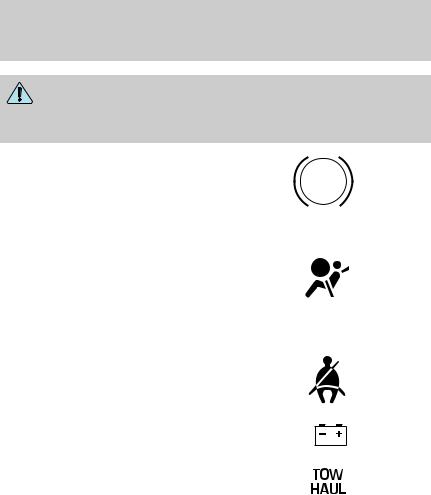
Instrument Cluster
Driving a vehicle with the brake system warning light on is dangerous. A significant decrease in braking performance may
occur. It will take you longer to stop the vehicle. Have the vehicle checked by your authorized dealer immediately.
Anti-lock brake system: If the
ABS light stays illuminated or ABS continues to flash, a malfunction has
been detected, have the system serviced immediately. Normal
braking is still functional unless the brake warning light also is illuminated.
Airbag readiness: If this light fails to illuminate when ignition is turned to ON, continues to flash or remains on, have the system serviced
immediately. A chime will also sound when a malfunction in the supplemental restraint system has been detected.
Safety belt: Reminds you to fasten your safety belt. A chime will also sound to remind you to fasten your safety belt.
Charging system: Illuminates when the battery is not charging properly.
Transmission Tow/Haul Feature (automatic transmission):
Illuminates when the Tow/Haul feature has been activated. Refer to
the Driving chapter for transmission function and operation. If the light flashes steadily, have the system serviced immediately, damage to the transmission could occur.
Four wheel drive low: Illuminates when four-wheel drive low is engaged.
Four wheel drive indicator:
Illuminates when four-wheel drive is engaged.
LOW
RANGE
4x4
14
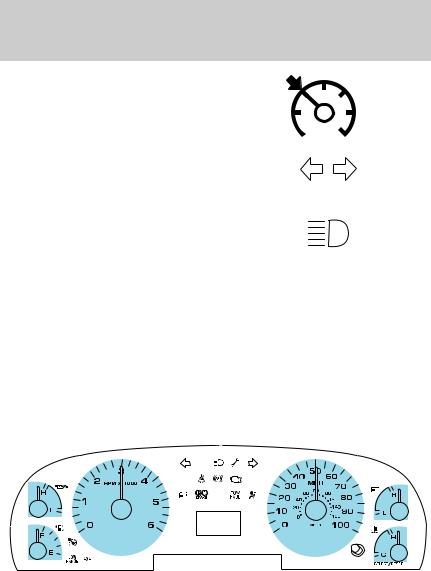
Instrument Cluster
Speed control: Illuminates when the speed control is activated. Turns off when the speed control system is deactivated.
Turn signal: Illuminates when the left or right turn signal or the hazard lights are turned on. If the
indicators stay on or flash faster, check for a burned out bulb.
High beams: Illuminates when the high beam headlamps are turned on.
Key-in-ignition warning chime: Sounds when the key is left in the ignition in the OFF, LOCK or ACCESSORY position and the driver’s door is opened.
Headlamps on warning chime: Sounds when the headlamps or parking lamps are on, the ignition is off (the key is not in the ignition) and the driver’s door is opened.
Parking brake ON warning chime: Sounds when the parking brake is set, the engine is running and the vehicle is driven more than 3 mph (5 km).
GAUGES
15
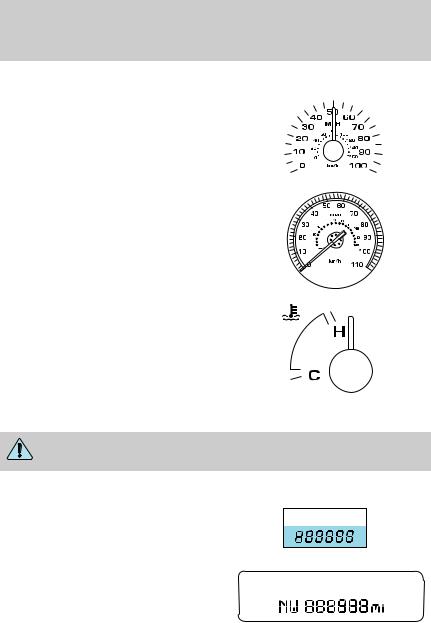
Instrument Cluster
Speedometer: Indicates the current vehicle speed.
Standard instrument cluster
Amarillo instrument cluster
Engine coolant temperature gauge: Indicates engine coolant
temperature. At normal operating temperature, the needle will be in
the normal range (between “H” and
“C”). If it enters the red section, the engine is overheating. Stop
the vehicle as soon as safely
possible, switch off the engine and let the engine cool.
Never remove the coolant reservoir cap while the engine is running or hot.
Odometer: Registers the total miles (kilometers) of the vehicle.
•With Mini Message Center
•With Full Message Center
Refer to Message Center in the Drivers Controls chapter on how to switch the display from Metric to English.
16
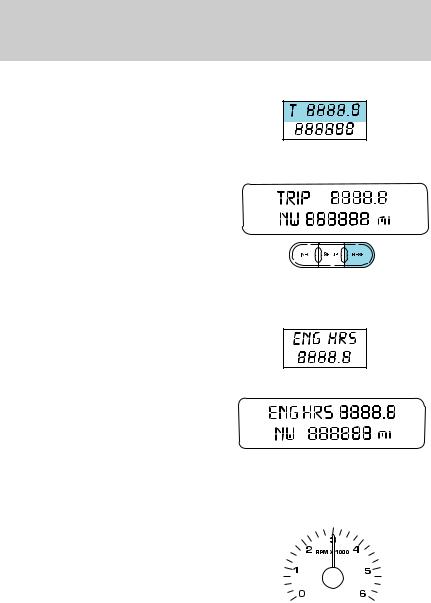
Instrument Cluster
Trip odometer: Registers the miles (kilometers) of individual journeys.
• With Mini Message Center
Press and release the SELECT/RESET button on the
cluster to toggle between odometer
and trip odometer display. To reset, press and hold for less than 2 seconds.
• With Full Message Center
Press and release the message center INFO button until TRIP mode appears in the display. Press the RESET button to reset.
Engine hour meter: Registers the accumulated time the engine has been running.
• With Mini Message Center
Press the SELECT/RESET button until the engine hours display.
• With Full Message Center
Press and release the message center INFO button until ENG HRS XXXX.X appears in the display. Press the RESET button to reset.
Tachometer: Indicates the engine speed in revolutions per minute. Driving with your tachometer pointer continuously at the top of the scale may damage the engine.
Standard instrument cluster
17

Instrument Cluster
Amarillo instrument cluster
Engine oil pressure gauge:
Indicates engine oil pressure. The needle should stay in the normal operating range (between “L” and
“H”). If the needle falls below the
normal range, stop the vehicle, turn off the engine and check the engine
oil level. Add oil if needed. If the oil
level is correct, have your vehicle checked at your authorized dealer.
Fuel gauge: Indicates approximately how much fuel is left in the fuel tank (when the ignition is in the ON position). The fuel gauge may vary slightly when the vehicle is in motion or on a grade.
Refer to Filling the tank in the Maintenance and Specifications chapter for more information.
Battery voltage gauge (manual transmission only): Indicates the battery voltage when the ignition is in the ON position. If the pointer moves and stays outside the normal operating range, have the vehicle’s electrical system checked as soon as possible.
18
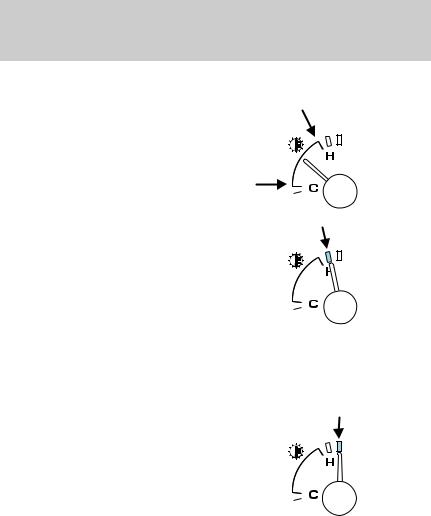
Instrument Cluster
Transmission fluid temperature gauge (automatic transmission only): If the gauge is in the:
Normal area (normal) - the transmission fluid is within the normal operating temperature (between “H” and “C”).
Yellow area (warning) — the transmission fluid is higher than
normal operating temperature. This can be caused by special operation conditions (i.e. snowplowing, towing
or off road use). Refer to Special Operating Conditions in the scheduled maintenance
information for instructions. Operating the transmission for extended periods of time with the gauge in the yellow area may cause internal transmission damage.
Altering the severity of the driving conditions is recommended to lower the transmission temperature into the normal range.
Red area (over temperature) — the transmission fluid is overheating. Stop the vehicle to allow the temperature to return to normal range.
If the gauge is operating in the Yellow or Red area, stop the vehicle and verify the airflow is not restricted such as snow or debris blocking airflow through the grill. If the gauge continues to show high temperatures, see your authorized dealer.
19
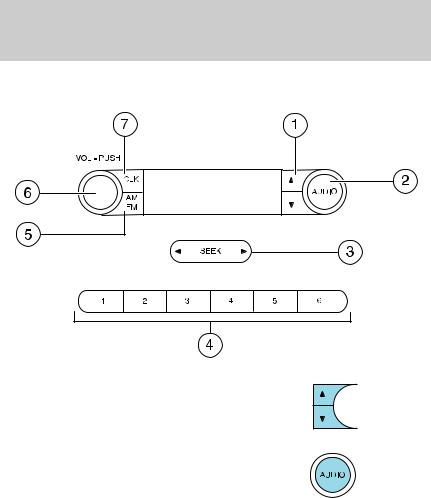
Entertainment Systems
AUDIO SYSTEMS
AM/FM stereo system (if equipped)
1.  /
/  Tuner: Press to
Tuner: Press to
manually go up or down the radio frequency. Also use in menu mode to select various settings.
2. Audio: Press to access select various settings.
Treble: Press to adjust the treble setting. Use  /
/ /
/ SEEK, SEEK
SEEK, SEEK  .
.
Bass: Press to adjust the bass setting. Use  /
/ /
/ SEEK, SEEK
SEEK, SEEK  .
.
Balance: Press to adjust the audio between the left and right speakers. Use  /
/ /
/ SEEK, SEEK
SEEK, SEEK  .
.
Fade: Press to adjust the audio between the front and rear speakers. Use  /
/ /
/ SEEK, SEEK
SEEK, SEEK  .
.
20
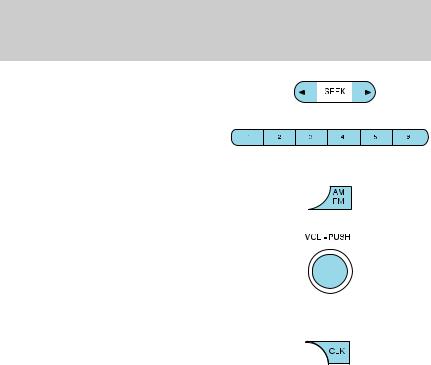
Entertainment Systems
3. Seek: Press to access the next/previous strong station or track.
4. Memory presets: To set a station: Select frequency band AM/FM; tune to a station, press and
hold a preset button until sound returns.
5. AM/FM: Press to select AM/FM frequency band.
6. ON/OFF/Volume: Press to turn ON/OFF. Turn to increase/decrease
volume.
If the volume is set above a certain level and the ignition is turned off, the volume will come back on at a
“nominal” listening level when the ignition switch is turned back on.
7. CLK (Clock): Press to toggle
between the clock and radio display. To set the clock: Press and hold
CLK until the hours begin to flash.
Press  /
/ to manually decrease / increase the hours. Press CLK again to set the minutes.
to manually decrease / increase the hours. Press CLK again to set the minutes.
21
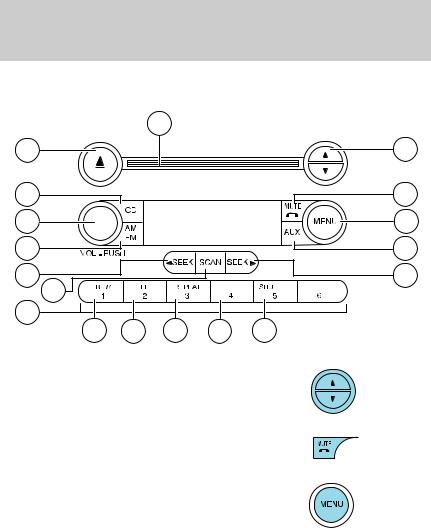
Entertainment Systems
AM/FM stereo/single CD sound system (if equipped)
|
|
18 |
|
|
17 |
|
|
|
1 |
16 |
|
|
|
2 |
15 |
|
|
|
3 |
14 |
|
|
|
4 |
13 |
|
|
|
5 |
12 |
|
|
COMPRESS |
|
|
|
|
|
|
11 |
|
|
|
|
10 |
9 |
8 |
7 |
6 |
1.  /
/  Tuner: Press to
Tuner: Press to
manually go up or down the radio frequency. Also use in menu mode to select various settings.
2. Phone/mute: Press to mute the playing media. Press again to return to the playing media.
3. Menu: Press to toggle through the following modes:
Autoset: Allows you to set the strongest local radio stations without losing your original manually set preset stations for AM/FM1/FM2 . Press
MENU to access. Use  /
/ /
/ SEEK
SEEK to set.
to set.
When the six strongest stations are filled, the station stored in preset 1 will begin playing. If there are less than six strong stations, the system will store the last one in the remaining presets.
Bass: Press to adjust the bass setting. Use  /
/ /
/ SEEK
SEEK  .
.
22
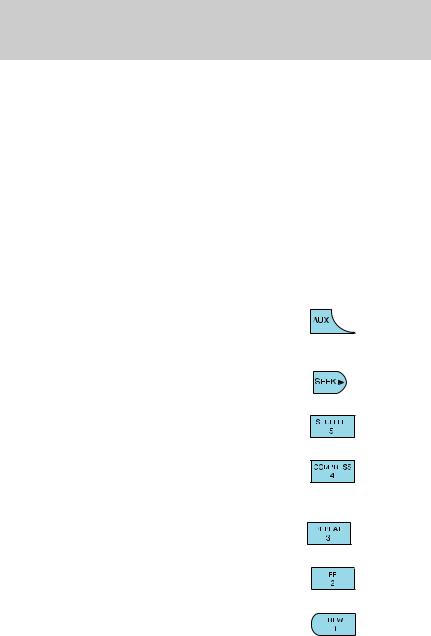
Entertainment Systems
Treble: Press to adjust the treble setting. Use  /
/ /
/ SEEK
SEEK  .
.
Balance: Press to adjust the audio between the left and right speakers. Use  /
/ /
/ SEEK
SEEK  .
.
Fade: Press to adjust the audio between the front and rear speakers. Use  /
/ /
/ SEEK
SEEK .
.
Speed sensitive volume (if equipped): Radio volume automatically changes slightly with vehicle speed to compensate for road and wind
noise. Press MENU to access and use  /
/ /
/ SEEK
SEEK  to adjust.
to adjust.
Setting the clock: Press MENU until SELECT HOUR or SELECT MINS is displayed. Use  /
/ to manually increase/decrease Press MENU again to disengage clock mode.
to manually increase/decrease Press MENU again to disengage clock mode.
4.Aux: Press to toggle between FES/DVD and AUX modes. If no auxiliary sources are available, NO AUX AUDIO will be displayed.
5.Seek: Press to access the next strong station or track.
6. Shuffle: Press to play tracks in random order.
7. Comp (Compression): In CD mode, brings soft and loud CD passages together for a more consistent listening level.
8. Repeat: Press to repeat the current CD track.
9. Fast forward: Press to manually advance in a CD track.
10. Rewind: Press to manually reverse in a CD track.
23
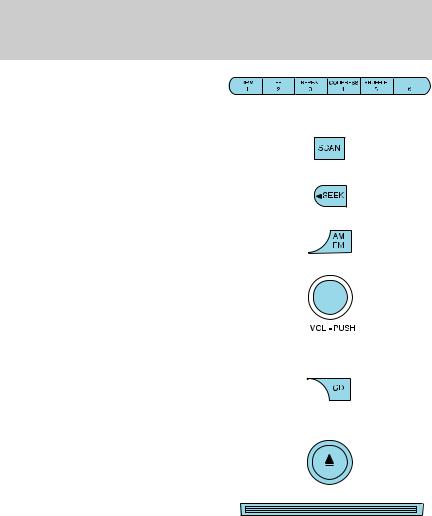
Entertainment Systems
11. Memory presets: To set a station: Select frequency band AM/FM; tune to a station, press and
hold a preset button until sound returns.
12.Scan: Press for a brief sampling of radio stations or CD tracks. Press again to stop.
13.Seek: Press to access the previous strong station or track.
14. AM/FM: Press to select AM/FM frequency band.
15.ON/OFF/Volume: Press to turn ON/OFF. Turn to increase/decrease volume.
If the volume is set above a certain level and the ignition is turned off, the volume will come back on at a
“nominal” listening level when the ignition switch is turned back on.
16.CD: Press to enter CD mode. If
a CD is already loaded into the system, CD play will begin where it ended last.
17. CD eject: Press to eject a CD.
18. CD slot: Insert a CD label side up.
24
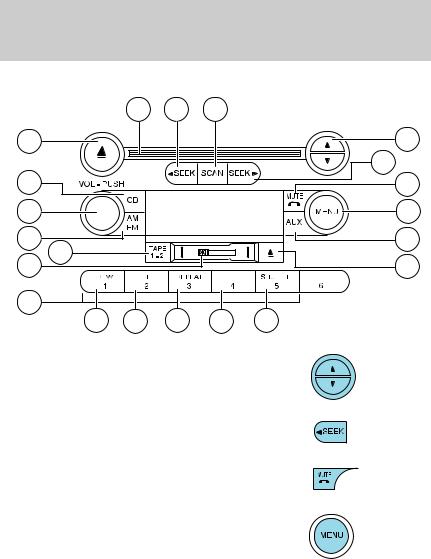
Entertainment Systems
AM/FM stereo cassette/single CD sound system (if equipped)
|
19 |
20 |
21 |
|
18 |
|
|
|
1 |
|
|
|
|
2 |
17 |
|
|
|
3 |
16 |
|
|
|
4 |
15 |
|
|
|
5 |
14 |
|
|
DOLBY B NR |
|
13 |
|
|
COMPRESS |
6 |
|
|
|
|
|
12 |
|
|
|
|
11 |
10 |
9 |
8 |
7 |
1.  /
/  Tuner: Press to
Tuner: Press to
manually go up or down the radio frequency. Also use in menu mode to select various settings.
2.Seek: Press to access the next strong station or track.
3.Phone/mute: Press to mute the
playing media. Press again to return to the playing media.
4. Menu: Press to toggle through the following modes:
Treble: Press to adjust the treble setting. Use  /
/ /
/ SEEK
SEEK .
.
Bass: Press to adjust the bass setting. Use  /
/ /
/ SEEK
SEEK .
.
Balance: Press to adjust the audio between the left and right speakers. Use  /
/ /
/ SEEK
SEEK  .
.
25
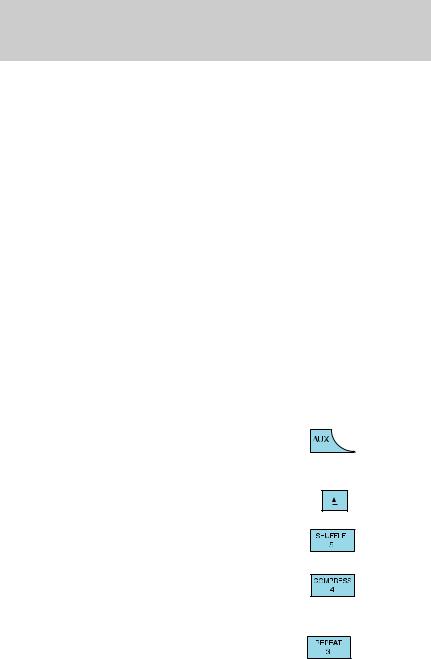
Entertainment Systems
Fade: Press to adjust the audio between the front and rear speakers. Use  /
/ /
/ SEEK
SEEK .
.
Speed sensitive volume (if equipped): Radio volume automatically changes slightly with vehicle speed to compensate for road and wind
noise. Press MENU to access and use  /
/ /
/ SEEK
SEEK to adjust.
to adjust.
Setting the clock: Press MENU until SELECT HOUR or SELECT MINS is displayed. Press  /
/ /
/ SEEK
SEEK to adjust the hours/minutes.
to adjust the hours/minutes.
Autoset: Allows you to set the strongest local radio stations without losing your original manually set preset stations for AM/FM1/FM2 . Press
MENU to access. Use  /
/ /
/ SEEK
SEEK  to set.
to set.
When the six strongest stations are filled, the station stored in preset 1 will begin playing. If there are less than six strong stations, the system will store the last one in the remaining presets.
Dolby noise reduction: In tape mode, this feature reduces tape noise and hiss. Press  /
/ /
/ SEEK
SEEK to cycle ON/OFF. The Dolby noise
to cycle ON/OFF. The Dolby noise
reduction system is manufactured under license from Dolby Laboratories Licensing Corporation. Dolby and double-D are registered trademarks of Dolby Laboratories Licensing Corporation.
5. AUX: Press to toggle between FES/DVD and AUX modes. If no auxiliary sources are available, NO
AUX AUDIO will be displayed. To return to radio mode, press AM/FM.
6. Tape eject: Press to eject a tape.
7. Shuffle: Press to play CD tracks in random order.
8. Compress (Compression): In CD mode, brings soft and loud CD passages together for a more consistent listening level.
9. Repeat: Press to repeat the current CD track.
26
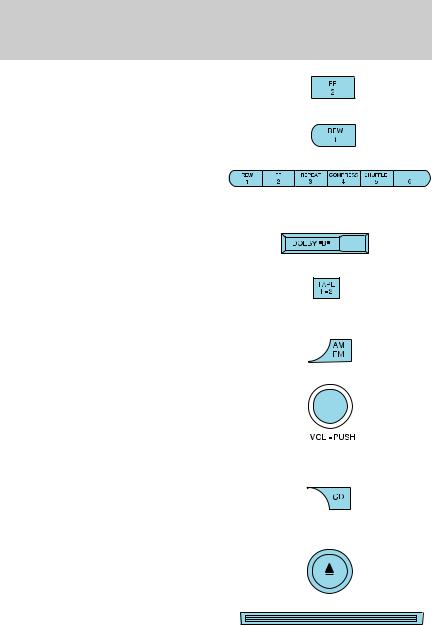
Entertainment Systems
10. Fast forward: Press to manually advance in a CD track or cassette.
11. Rewind: Press to manually reverse in a CD track or cassette.
12. Memory presets: To set a station: Select frequency band AM/FM; tune to a station, press and
hold a preset button until sound returns.
13. Tape: Insert a tape facing to the right.
14. Tape direction: Press to enter tape mode. Press while in play mode to change which side of the tape is playing.
15. AM/FM: Press to select AM/FM frequency band.
16.ON/OFF/Volume: Press to turn ON/OFF. Turn to increase/decrease volume.
If the volume is set above a certain level and the ignition is turned off, the volume will come back on at a
“nominal” listening level when the ignition switch is turned back on.
17.CD: Press to enter CD mode. If
a CD is already loaded into the system, CD play will begin where it ended last.
18. CD eject: Press to eject a CD.
19. CD slot: Insert a CD label side up.
27

Entertainment Systems
20.Seek: Press to access the previous strong station or track.
21.Scan: Press for a brief sampling of radio stations or CD tracks. Press again to stop.
When this radio is used in cargo vans where no rear speakers are installed in the vehicle, fading to the rear speakers will result in no audio output.
Premium in-dash six CD sound system (if equipped)
|
18 |
|
19 |
|
|
|
|
|
|
|
1 |
17 |
LOAD |
|
|
|
|
16 |
|
|
|
|
2 |
15 |
|
|
|
|
3 |
14 |
|
|
|
|
4 |
13 |
12 |
|
|
COMPRESS |
5 |
|
|
|
|
||
|
|
|
|
|
|
11 |
|
|
|
|
|
|
10 |
9 |
8 |
7 |
6 |
1.  /
/  Tuner: Press to
Tuner: Press to
manually go up or down the radio frequency. Also use in menu mode to select various settings.
2. Phone/mute: Press to mute the playing media. Press again to return to the playing media.
28
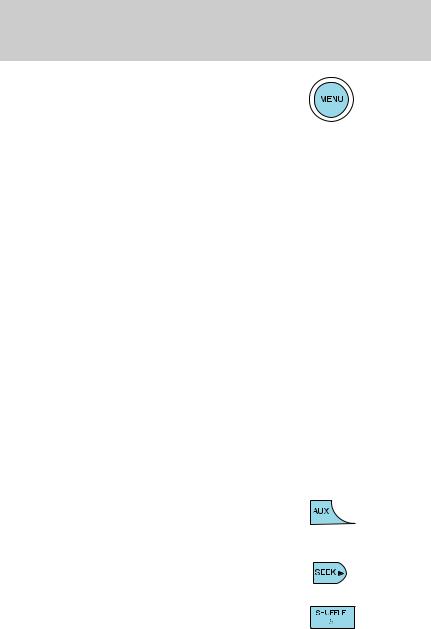
Entertainment Systems
3. Menu: Press to toggle through the following modes:
Autoset: Allows you to set the strongest local radio stations without losing your original manually set preset stations for AM/FM1/FM2 . Press
MENU to access. Use  /
/ /
/ SEEK
SEEK  to set.
to set.
When the six strongest stations are filled, the station stored in preset 1 will begin playing. If there are less than six strong stations, the system will store the last one in the remaining presets.
Bass: Press to adjust the bass setting. Use  /
/ /
/ SEEK
SEEK .
.
Treble: Press to adjust the treble setting. Use  /
/ /
/ SEEK
SEEK .
.
Balance: Press to adjust the audio between the left and right speakers. Use  /
/ /
/ SEEK
SEEK .
.
Fade: Press to adjust the audio between the front and rear speakers. Use  /
/ /
/ SEEK
SEEK .
.
Speed sensitive volume (if equipped): Radio volume automatically changes slightly with vehicle speed to compensate for road and wind
noise. Press MENU to access and use  /
/ /
/ SEEK
SEEK  to adjust.
to adjust.
Setting the clock: Press MENU until SELECT HOUR or SELECT MINS is displayed. Press  /
/ /
/ SEEK
SEEK  to adjust the hours/minutes.
to adjust the hours/minutes.
4.Aux: Press to toggle between FES/DVD and AUX modes. If no auxiliary sources are available, NO AUX AUDIO will be displayed.
5.Seek: Press to access the next strong station or track.
6. Shuffle: Press to play tracks in random order.
29
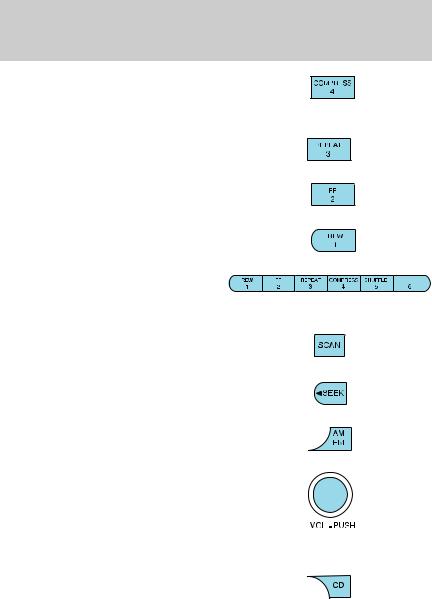
Entertainment Systems
7.Comp (Compression): In CD mode, brings soft and loud CD passages together for a more consistent listening level.
8.Repeat: Press to repeat the current CD track.
9.Fast forward: Press to manually advance in a CD track.
10.Rewind: Press to manually reverse in a CD track.
11. Memory presets: To set a station: Select frequency band AM/FM; tune to a station, press and
hold a preset button until sound returns.
12.Scan: Press for a brief sampling of radio stations or CD tracks. Press again to stop.
13.Seek: Press to access the previous strong station or track.
14.AM/FM: Press to select AM/FM frequency band.
15.ON/OFF/Volume: Press to turn ON/OFF. Turn to increase/decrease volume.
If the volume is set above a certain level and the ignition is turned off, the volume will come back on at a
“nominal” listening level when the ignition switch is turned back on.
16.CD: Press to enter CD mode. If
a CD is already loaded into the system, CD play will begin where it ended last.
30
